
Great White Shark, South Neptune Islands, South Australia.
Species: Great white shark, Carcharodon carcharias
Location: South Neptune Islands, South Australia
Image ID: 39139
Species: Great white shark, Carcharodon carcharias
Location: South Neptune Islands, South Australia
Image ID: 39139

Great White Shark, South Neptune Islands, South Australia.
Species: Great white shark, Carcharodon carcharias
Location: South Neptune Islands, South Australia
Image ID: 39140
Species: Great white shark, Carcharodon carcharias
Location: South Neptune Islands, South Australia
Image ID: 39140

Great White Shark, South Neptune Islands, South Australia.
Species: Great white shark, Carcharodon carcharias
Location: South Neptune Islands, South Australia
Image ID: 39141
Species: Great white shark, Carcharodon carcharias
Location: South Neptune Islands, South Australia
Image ID: 39141

Ocean sunfish recruiting fish near drift kelp to clean parasites, open ocean, Baja California.
Species: Ocean sunfish, Mola mola
Image ID: 03267
Species: Ocean sunfish, Mola mola
Image ID: 03267

Tiger shark and horse-eye jacks.
Species: Tiger shark, Galeocerdo cuvier
Location: Bahamas
Image ID: 31880
Species: Tiger shark, Galeocerdo cuvier
Location: Bahamas
Image ID: 31880

Bigeye trevally jacks, motion blur, schooling.
Species: Bigeye jack, Caranx sexfasciatus
Location: Darwin Island, Galapagos Islands, Ecuador
Image ID: 16347
Species: Bigeye jack, Caranx sexfasciatus
Location: Darwin Island, Galapagos Islands, Ecuador
Image ID: 16347

The bright orange garibaldi fish, California's state marine fish, is also clownlike in appearance.
Species: Garibaldi, Hypsypops rubicundus
Location: California
Image ID: 02416
Species: Garibaldi, Hypsypops rubicundus
Location: California
Image ID: 02416
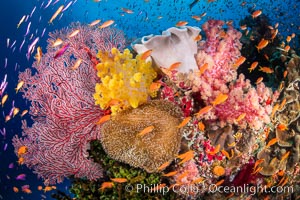
Brilliantlly colorful coral reef, with swarms of anthias fishes and soft corals, Fiji.
Species: Anthias, Dendronephthya soft coral, Dendronephthya, Pseudanthias
Location: Bligh Waters, Fiji
Image ID: 34708
Species: Anthias, Dendronephthya soft coral, Dendronephthya, Pseudanthias
Location: Bligh Waters, Fiji
Image ID: 34708

Beautiful South Pacific coral reef, with Plexauridae sea fans, schooling anthias fish and colorful dendronephthya soft corals, Fiji.
Species: Anthias, Dendronephthya soft coral, Gorgonian, Dendronephthya, Gorgonacea, Pseudanthias
Location: Fiji
Image ID: 34716
Species: Anthias, Dendronephthya soft coral, Gorgonian, Dendronephthya, Gorgonacea, Pseudanthias
Location: Fiji
Image ID: 34716

Brilliantlly colorful coral reef, with swarms of anthias fishes and soft corals, Fiji.
Species: Anthias, Dendronephthya soft coral, Dendronephthya, Pseudanthias
Location: Bligh Waters, Fiji
Image ID: 34720
Species: Anthias, Dendronephthya soft coral, Dendronephthya, Pseudanthias
Location: Bligh Waters, Fiji
Image ID: 34720

Brilliantlly colorful coral reef, with swarms of anthias fishes and soft corals, Fiji.
Species: Anthias, Dendronephthya soft coral, Dendronephthya, Pseudanthias
Location: Bligh Waters, Fiji
Image ID: 34722
Species: Anthias, Dendronephthya soft coral, Dendronephthya, Pseudanthias
Location: Bligh Waters, Fiji
Image ID: 34722
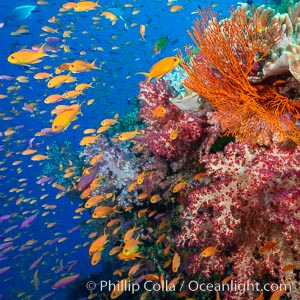
Brilliantlly colorful coral reef, with swarms of anthias fishes and soft corals, Fiji.
Species: Anthias, Dendronephthya soft coral, Dendronephthya, Pseudanthias
Location: Bligh Waters, Fiji
Image ID: 34723
Species: Anthias, Dendronephthya soft coral, Dendronephthya, Pseudanthias
Location: Bligh Waters, Fiji
Image ID: 34723

Beautiful South Pacific coral reef, with Plexauridae sea fans, schooling anthias fish and colorful dendronephthya soft corals, Fiji.
Species: Anthias, Dendronephthya soft coral, Gorgonian, Dendronephthya, Gorgonacea, Pseudanthias
Location: Namena Marine Reserve, Namena Island, Fiji
Image ID: 34726
Species: Anthias, Dendronephthya soft coral, Gorgonian, Dendronephthya, Gorgonacea, Pseudanthias
Location: Namena Marine Reserve, Namena Island, Fiji
Image ID: 34726

Brilliantlly colorful coral reef, with swarms of anthias fishes and soft corals, Fiji.
Species: Anthias, Dendronephthya soft coral, Dendronephthya, Pseudanthias
Location: Namena Marine Reserve, Namena Island, Fiji
Image ID: 34727
Species: Anthias, Dendronephthya soft coral, Dendronephthya, Pseudanthias
Location: Namena Marine Reserve, Namena Island, Fiji
Image ID: 34727

Golden Damselfish, Fiji.
Species: Golden damselfish, Amblyglyphidodon aureus
Location: Namena Marine Reserve, Namena Island, Fiji
Image ID: 34734
Species: Golden damselfish, Amblyglyphidodon aureus
Location: Namena Marine Reserve, Namena Island, Fiji
Image ID: 34734

Bignose Unicornfish, Naso vlamingii, being cleaned by a small wrasse, Fiji.
Species: Bignose unicornfish, Naso vlamingii
Location: Namena Marine Reserve, Namena Island, Fiji
Image ID: 34735
Species: Bignose unicornfish, Naso vlamingii
Location: Namena Marine Reserve, Namena Island, Fiji
Image ID: 34735
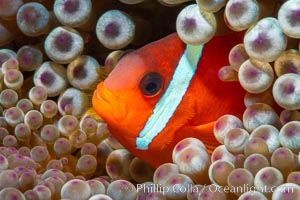
Fiji Barberi Clownfish, Amphiprion barberi, hiding among anemone tentacles, Fiji.
Species: Fiji barberi clownfish, Amphiprion barberi
Location: Namena Marine Reserve, Namena Island, Fiji
Image ID: 34736
Species: Fiji barberi clownfish, Amphiprion barberi
Location: Namena Marine Reserve, Namena Island, Fiji
Image ID: 34736
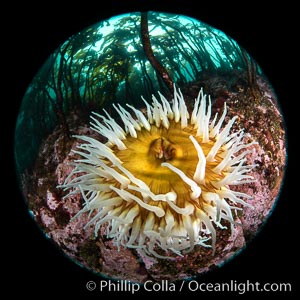
The Fish Eating Anemone Urticina piscivora, a large colorful anemone found on the rocky underwater reefs of Vancouver Island, British Columbia.
Species: Fish-eating anemone, Urticina piscivora
Location: British Columbia, Canada
Image ID: 35249
Species: Fish-eating anemone, Urticina piscivora
Location: British Columbia, Canada
Image ID: 35249
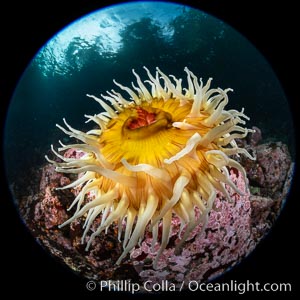
The Fish Eating Anemone Urticina piscivora, a large colorful anemone found on the rocky underwater reefs of Vancouver Island, British Columbia.
Species: Fish-eating anemone, Urticina piscivora
Location: British Columbia, Canada
Image ID: 35255
Species: Fish-eating anemone, Urticina piscivora
Location: British Columbia, Canada
Image ID: 35255
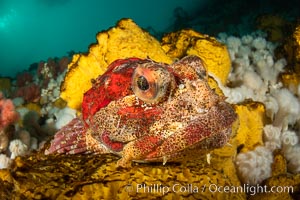
Red Irish Lord sculpinfish, Browning Pass, British Columbia.
Species: Red irish lord, Hemilepidotus hemilepidotus
Location: British Columbia, Canada
Image ID: 35256
Species: Red irish lord, Hemilepidotus hemilepidotus
Location: British Columbia, Canada
Image ID: 35256

Giant Plumose Anemones cover underwater reef, Browning Pass, northern Vancouver Island, Canada.
Species: Giant plumose anemone, Metridium farcimen
Location: British Columbia, Canada
Image ID: 35284
Species: Giant plumose anemone, Metridium farcimen
Location: British Columbia, Canada
Image ID: 35284

Parasitic zoanthid anemones cover, encrust and overwhelm a golden gorgonian. The gorgonian on the left has been completely parasitized by zoanthid anemones, while the gorgonian to the right remains free of zoanthids (for now). A garibaldi swims below the two sea fans. The golden gorgonian is a filter-feeding temperate colonial species that lives on the rocky bottom at depths between 50 to 200 feet deep. Each individual polyp is a distinct animal, together they secrete calcium that forms the structure of the colony. Gorgonians are oriented at right angles to prevailing water currents to capture plankton drifting by.
Species: California golden gorgonian, Luminescent parazoanthid, Zoanthid anemone, Giant kelp, Muricea californica, Parazoanthus lucificum, Savalia lucifica, Macrocystis pyrifera
Location: San Clemente Island, California
Image ID: 38493
Species: California golden gorgonian, Luminescent parazoanthid, Zoanthid anemone, Giant kelp, Muricea californica, Parazoanthus lucificum, Savalia lucifica, Macrocystis pyrifera
Location: San Clemente Island, California
Image ID: 38493

Ocean Sunfish swimming at the ocean surface in the Open Ocean.
Species: Ocean sunfish, Mola mola
Location: San Diego, California
Image ID: 39406
Species: Ocean sunfish, Mola mola
Location: San Diego, California
Image ID: 39406

Two Giant Black Sea Bass in a Courtship Posture, in Kelp at Catalina Island. In summer months, black seabass gather in kelp forests in California to form mating aggregations. Courtship behaviors include circling of pairs of giant sea bass, production of booming sounds by presumed males, and nudging of females by males in what is though to be an effort to encourage spawning.
Species: Giant black sea bass, Stereolepis gigas
Location: Catalina Island, California
Image ID: 39432
Species: Giant black sea bass, Stereolepis gigas
Location: Catalina Island, California
Image ID: 39432

Giant Black Sea Bass with Distinctive Identifying Black Spots that allow researchers to carry out sight/resight studies on the animals distributions and growth. Black sea bass can reach 500 pounds and 8 feet in length.
Species: Giant black sea bass, Stereolepis gigas
Location: Catalina Island, California
Image ID: 39433
Species: Giant black sea bass, Stereolepis gigas
Location: Catalina Island, California
Image ID: 39433

Scythe-mark butterflyfish, Prognathodes falcifer, Catalina Island.
Species: Scythe-mark butterflyfish, Prognathodes falcifer
Location: Catalina Island, California
Image ID: 40516
Species: Scythe-mark butterflyfish, Prognathodes falcifer
Location: Catalina Island, California
Image ID: 40516

Spectacular pristine tropical reef, including dendronephthya soft corals, sarcophyton leather corals and schooling Anthias fishes, pulsing with life in a strong current over a pristine coral reef. Fiji is known as the soft coral capitlal of the world.
Species: Anthias, Dendronephthya soft coral, Sarcophyton soft coral, Dendronephthya, Pseudanthias, Sarcophyton
Location: Namena Marine Reserve, Namena Island, Fiji
Image ID: 31309
Species: Anthias, Dendronephthya soft coral, Sarcophyton soft coral, Dendronephthya, Pseudanthias, Sarcophyton
Location: Namena Marine Reserve, Namena Island, Fiji
Image ID: 31309

Beautiful South Pacific coral reef, with gorgonian sea fans, schooling anthias fish and colorful dendronephthya soft corals, Fiji.
Species: Anthias, Black sun coral, Dendronephthya soft coral, Gorgonian, Dendronephthya, Gorgonacea, Pseudanthias, Tubastrea micrantha
Location: Fiji
Image ID: 31312
Species: Anthias, Black sun coral, Dendronephthya soft coral, Gorgonian, Dendronephthya, Gorgonacea, Pseudanthias, Tubastrea micrantha
Location: Fiji
Image ID: 31312

Spectacular pristine tropical reef with vibrant colorful soft corals. Dendronephthya soft corals, crinoids, sea fan gorgonians and schooling Anthias fishes, pulsing with life in a strong current over a pristine coral reef. Fiji is known as the soft coral capitlal of the world.
Species: Anthias, Black sun coral, Crinoid feather star, Dendronephthya soft coral, Gorgonian, Crinoidea, Dendronephthya, Gorgonacea, Pseudanthias, Tubastrea micrantha
Location: Vatu I Ra Passage, Bligh Waters, Viti Levu Island, Fiji
Image ID: 31313
Species: Anthias, Black sun coral, Crinoid feather star, Dendronephthya soft coral, Gorgonian, Crinoidea, Dendronephthya, Gorgonacea, Pseudanthias, Tubastrea micrantha
Location: Vatu I Ra Passage, Bligh Waters, Viti Levu Island, Fiji
Image ID: 31313

Colorful Dendronephthya soft corals and schooling Anthias fish on coral reef, Fiji.
Species: Anthias, Black sun coral, Dendronephthya soft coral, Dendronephthya, Pseudanthias, Tubastrea micrantha
Location: Vatu I Ra Passage, Bligh Waters, Viti Levu Island, Fiji
Image ID: 31316
Species: Anthias, Black sun coral, Dendronephthya soft coral, Dendronephthya, Pseudanthias, Tubastrea micrantha
Location: Vatu I Ra Passage, Bligh Waters, Viti Levu Island, Fiji
Image ID: 31316